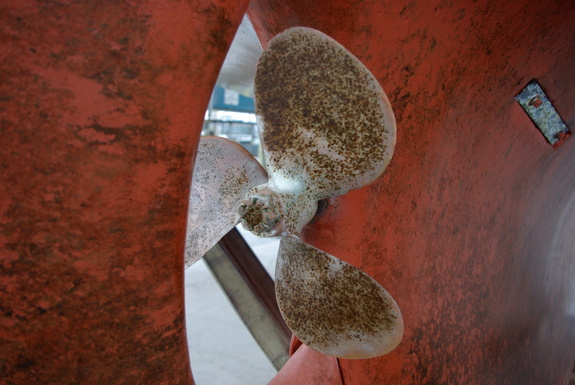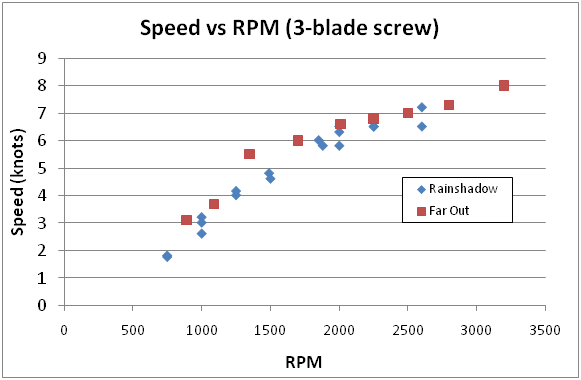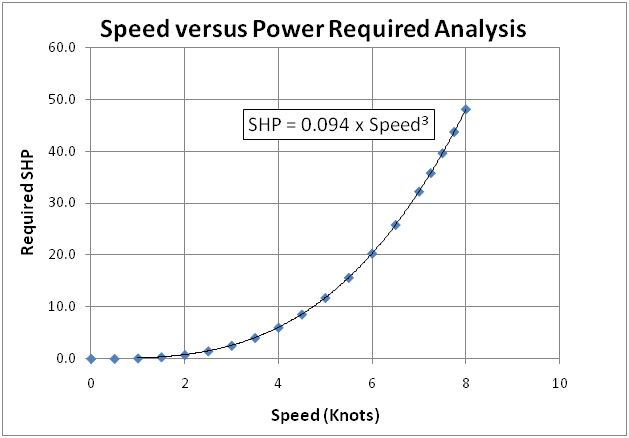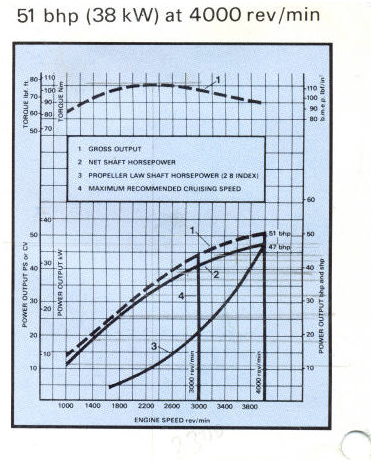Prop Analysis and Replacement – Part I

May 28th, 2011 | by Van | Published in Maintenance and Repairs, Upgrades | 1 Comment
Rainshadow has a 16 inch diameter, 12 inch pitch propeller that is specified by Camper and Nicholson for the Nic 38. It sits in an aperture, which is about 20 inches in diameter. She also has the original Perkins 4-108 with a 2:1 reduction transmission. We find there are three major problems.Firstly, at about 2000 RPM cavitation begins. It sounds just like gravel getting sucked though the prop. Horrible. Secondly, the propeller noise is loud – unpleasantly loud. And finally, her wide open throttle under load (WOT) RPM is just 2600. WOT out of gear is >3600 (we didn’t go above that). The manufacture’s design specs for “intermittent duty” load (which means running at that level for no more than an hour at a time) is 3600 RPM, and “continuous duty” load is 3000 RPM. So, Rainshadow is over propped and it’s time to fix that.
What does over propped mean? Basically, an engine can produce a certain number of HP at any given RPM. A prop requires a certain HP to turn it at any given RPM. When, at a given RPM, the HP required by a prop exceeds the HP that the engine can produce, you get a stalemate – you cannot raise the RPM any higher because the engine does not have the “oomph” to push the prop any faster. Worse, the engine cannot reach its full strength because to do so requires running at a higher RPM. So you are running a nominally 50 BHP engine and getting much less out – at 2600 RPM, the engine can only produce about 37 HP. This is not good if you are trying to power off a lee shore, or are motoring into a headwind and waves. And it’s bad for diesel engines to run at lower than rated RPM.
Below is a chart for Speed vs RPM for Rainshadow and also for Far Out, Arild Jaeger’s Nic 38, also with a 16×12 prop. Arild posted his data to the Nic38 forum at www.nicholson38.org. We also calibrated our tachometer, and found it consistently low by 5%. As you can see, hull speed is somewhere in the region of 7.5 – 7.8 knots. Note, we have sailed faster than we were able to achieve while motoring with this prop.

Prop Sizing
So, I set about trying to understand how props are sized. There is a ton of superficial information on the Internet, with many places having a “prop selection tool”. None were very convincing or satisfying. The best source of information has been David Gerr’s book: Propeller Handbook : The Complete Reference for Choosing, Installing, and Understanding Boat Propellers. This is a wonderfully detailed book, with lots of data and empirical formulae to help figure things out. If you really care about understanding props, buy it. Of course, if you “don’t need no stinkin’ formula” (to quote Bob Perry on Cruiser’s Forum), or don’t believe in them, then it’s not for you. (It only uses high school level math and most equations are also presented as graphs where you can just look up the relevant values).
I liked this book so much I bought another of his books sight unseen – Boat Mechanical Systems Handbook: How to Design, Install, and Recognize Proper Systems in Boats. This is also really good, and practical, and focuses on the mechanical systems of boats.
There are some people who claim that prop selection is an “Art” and you have to get a professional to help you. So, I called up several of the “professionals” who were recommended by various knowledgeable people (including Max Prop in Seattle, the Prop Shop in Everett, and some others), and funny thing – I got different responses from all of them. One recommended a 15×9, one a 16×12, and another a 17×12. It seems more trial and error – you try a prop and if it doesn’t work, you try a different one….. at your own cost. Just make sure the prop shop will exchange the old new one for a “new” new one.
So, I took Gerr’s book, and ported relevant parts to a spreadsheet (specifically Crouch’s method). I now have a fairly simple spreadsheet that incorporates most of what’s needed to do a complete prop analysis for Rainshadow. And the results are interesting. Firstly, it clearly depends on the characteristics of the boat – hull shape, etc. These are hard to quantify. Some factors you can measure (such as hull speed). Some you have to guess. That’s why there does not seem to be a simple answer.
I’ll describe the calculations here, but if you want to understand where they came from and the justification for them, you’ll need to refer to Gerr’s book. Importantly, Gerr’s book will help you apply the right numbers to get better results.
Input parameters
The engine is the key factor in the analysis. Here is data from the Perkins 4-108 manual that came with the boat:
| Perkins 4-108 Manual | HP | @RPM |
| Max Brake HP | 50 | 4000 |
| Max Intermittent Duty Rating | 45 | 3600 |
| Max Continuous Duty Rating | 37 | 3000 |
The reduction ratio of the transmission is 2:1.
For the analysis, I assumed some HP were lost to the alternator, transmission, etc. giving a Shaft HP (SHP) of 43.5 HP at the Intermittent Duty Rating.
Next, several physical characteristics of the boat are needed:
| Nicholson 38 | |
| Displacement * | 16,000 lbs |
| LWL** | 27 feet |
| Beam at waterline | 9 feet |
| Draft excluding keel | 1.5 feet |
| Depth of prop shaft | 2.5 feet |
| Theoretical hull speed *** | 7.8 knots |
* Jeremy Lines, one of the C&N designers, says the quoted 16,000 lbs displacement for the Nic 38 is for a moderately loaded vessel, with half full tanks. Using 18,000 lbs for fully loaded reduces theoretical hull speed to 7.5.
** The LWL underway is significantly increased by the large overhangs at the bow and stern. Underway, the LWL extends all the way back to the end of the transom, and forward some distance as well. 29 feet is probably a reasonable value underway, which would increase the hull speed to about 8.1 knots.
Gerr’s calculation for Hull Speed uses LWL, Displacement and Shaft HP to calculate hull speed. The old 1.34 x √LWL is just an approximation used for “average” boats.
Hull Speed = 10.665 √LWL*((SHP at Max Int)/Displacement)^(-0.333)
For Rainshadow, this gives a Hull Speed = 7.8 knots.
Gerr’s equation can of course be inverted to calculate the power required for any given speed, as shown below (calculated assuming LWL = 30 feet).
Required SHP=Displacement*(Speed/((10.665*√LWL))^3

Calculating the Diameter
The next set of calculations use the actual shaft HP (SHP of 43.5), and shaft RPM (SRPM) at the Max Intermittent Duty Rating to calculate prop diameter:
Prop Diameter= 632.7*(SHP^0.2)/(SRPM^0.6 )
For Rainshadow, this works out to 15”.
Gerr says to make the diameter calculation using the intermittent duty rating for the engine. Gerr’s method works by calculating where the engine power and the prop power curves cross on a power vs RPM chart. The method chooses a prop so that the prop power curve crosses at the intermittent duty HP and RPM (line 2 and line 3 in the diagram below, taken from the Perkins 4-108 sales pamphlet ca 1984).

I copied the engine power curve off the chart and worked out the equation SHP as a function of RPM:
SHP (RPM) = -3 x 10-6 x RPM2 + 0.0262 x RPM – 12.652
Calculating Pitch
Pitch is calculated based on the continuous duty rating for the engine. One of the input parameters is the “slip” of the prop. If the prop were a screw in wood, it would have zero slip. Because water is not solid, the prop “slips”, and the proportion is called the slip. Using data for Far Out and Rainshadow, I calculate the slip to be 45% to 50%. Gerr also gives an empirical formula:
Slip=1.4/(Speed at Max Cont Duty)^0.57
which works out to be 44% for the Nic 38.
The pitch calculation starts by calculating the zero slip pitch from the speed and shaft RPM at the Max Continuous Duty rating. This works out to be 6.3 inches. Then, dividing by the slip gives you the actual pitch required – this works out to be 12.5 to 13.9 inches (for slip = 0.45 and 0.5 respectively).
Gerr has a rule of thumb that 1” of diameter absorbs 2” of pitch. So a 15×12 prop is nominally equivalent to a 16×10. This suggests the 16×12 may be too large for the 4-108 with the 2:1 reduction ratio.
Propagation of Errors
Next, I did something called “propagation of errors” to the analysis. This is a standard technique in science where you account for uncertainties in the input parameters. For instance, in the pitch calculation, you use the slip factor. You can find this by measuring the boat speed through the water vs RPM. Then, it’s simple math. The measurement works out to be about 50% at max RPM. However, the experimental error (uncertainty) is about +/- 5%. So really, it might be 45% or it might be 55%. In a propagation of errors calculation, you work out values for both extremes. With this, you get a pitch ranging from 11.4 to 13.9 for that 15” diameter prop. The range for the prop diameter using this method is from 13.5” to 16.4”.
What this shows is that although these formula are helpful in general, they are not helpful in specifying the exact prop you need. I think this also shows why there is no such thing as a prop expert – there are just guidelines, and then you just need to try one out, and if it doesn’t work, try another. (Caveat – this is a little pessimistic – in fact there are ways of improving the odds if you have experimental data from the boat in question).
Cavitation
Gerr warns that the cavitation calculation is very approximate, but at least it is a guideline. It depends on calculating the effective pressure in front and behind the prop blades. When the negative pressure in front of the blade exceeds the vapor pressure of water, you get cavitation. In summary, the calculation shows that a three blade prop is highly likely to cavitate. The solution is to use a prop with a larger surface area – namely a four blade prop.
The Dilemma
The calculation concludes that a correctly sized prop for Rainshadow is a 15×12 pitch prop or perhaps a 16×10. However, although we should be able to reach hull speed at the right Max RPM, it also predicts that this will not solve the cavitation problem. To do that, we would need a 4 blade prop. However, no one makes a 15” four-blade prop. One option is a 16” 4-blade (actually a 17” that is cut down to 16” diameter) with a pitch of 10”. We got a quote for one for about $700 including shipping.
But what about drag under sail for three vs four blades?
I’ve not found any good analysis or empirical data on this. One can argue that a four blade prop won’t be that much different to a three blade prop (free to spin) because under sail, on average, a four blade prop has two blades sticking out into the main water flow, with two hidden behind the deadwood. For a three blade prop, on average, two blades are sticking out into the main water flow, with one hidden behind the deadwood. So, perhaps the difference would not be great. An in any case, we’re cruisers, not racers and if we really cared about drag under sail, we’d get a FeatherStream feathering prop.
There is also some fear that a four blade prop in an aperture would have worse noise because two blades are passing the deadwood at the same time. Dunno about that.
What we did
The calculations in Gerr’s book are based on empirical data taken for traditional screw props. A UK company called Axiom makes a prop that departs from that form factor, and instead uses what can be described as S shaped wings instead of screw shaped blades. They claim (and it’s somewhat backed up by independent testing by Yachting and Boating World) that compared to screw props, their blades provide equal or better thrust in forward, with dramatically better thrust in reverse, with less prop walk, and lastly, that they produce far less cavitation than screw props.
The better thrust in reverse is what initially attracted Marilyn to the prop – she’s at the helm and confirms that Nic 38s have a mind of their own in reverse. They just do what they want, and all you as the helmsman can do is give it power or not. Reports are that with Axiom props, unruly long keeled boats become relatively well behaved.
So, that what we did – we ordered an Axiom 16” x 19.5 degrees (Axiom calibrate their props by the angle of the blades, not the pitch of the prop).
Next: Part II – The Axiom Prop, where we report on the Axiom prop as installed
January 28th, 2016at 6:23 pm(#)
Wow – that’s a good read (but it is 2am so I will have to keep chapter 2 till another time).
Ever since buying Voltair, we have had an awful graunchy rear-shaft noise from about 1800 engine rpm upwards. I liken it to a grown-up version of the noise made by a Black and Decker 1960’s drill with dried out or worn oilite bearings. Hence we never cruise at more than 1800 rpm, just using the motor at up to 2200 in emergency situations, such as trying to make way against a 50-knot headwind in the River Shannon in 2003.
But I have never attributed it to the (original) prop – only ever to the white metal bearing, which is significantly worn. When we had our “on the rocks” episode in 2001, the heel of the keel was re-built, but the white metal bearing was not serviced. However, approx half-an inch of epoxy and glass was built up around the exterior of the prop tube all around, and we have never felt brave enough to hack all this off in order to get the bearing out. During one of our Norwegian winter haulouts I had to replace the GKN thrust bearing which had got drowned in seawater, and so brought home the stainless output shaft after of the bearing for servicing. We had it metal sprayed and ground back to size (it was worn by about 0.004″ to 0.006″ in the bearing zone) and after reinstallation we had a glorious 45 minutes at 2000 rpm and no graunching, before the noise re-appeared, gradually getting back to the 1800 rpm threshold we still notice. There’s no way a just-cleaned and painted prop would change its tune after 45 minutes and start cavitating, and we have cleaned and painted it 10 times since then, but never had freedom from “bearing noise”.